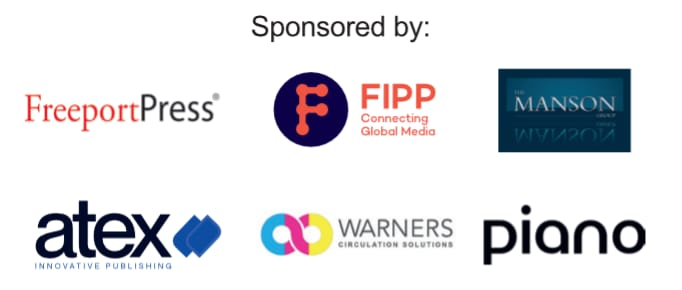- The Publisher Newsletter
- Posts
- Inside the print revival: Publishers find success with premium magazines
Inside the print revival: Publishers find success with premium magazines
At the heart of renewed interest in print publishing is the story of a pivot away from a mass media, mass market business model to embrace a premium, value-added ethos.
Welcome to The Publisher Newsletter, by Media Voices: your weekly newsletter profiling the people and products powering publishing.
Before we get into this week’s newsletter, Flashes & Flames has announced a major new event to assess the commercial, operational and competitive impact of AI for news, lifestyle and B2B media and events.
“The Definitive AI Forum for Media, Information & Events” will take place at London’s historic Stationers’ Hall on Tuesday 25 November 2025.
Inside the print revival: Publishers find success with premium magazines
Inside the Print Revival is a deep dive into the modern market for print magazines, examining the challenges and the opportunities in the renewed interest for print publishing and making some suggestions if you think it could be time to reinvest in print.
The Media Voices team has been wondering for some time about what is really going on in the print magazine market. We’ve watched the number of stories about print launches and relaunches grow from a trickle to, if not quite a tidal wave, a fairly fast flowing stream.
Talk of a print comeback, a fight back even, has been increasingly common in the magazine market. However, at the same time, news about magazine circulations dropping, print operations being scaled back and regular closures has continued.
So, with these two seemingly contradictory narratives competing for our attention, we decided to try to find out what is really going on. This week’s episode of The Publisher Podcast is an audio teaser for the report.
A print revival?
The first thing to realise about the Print Revival, is that print never really went away. The long-term decline in newspaper circulations has set the tone for the narrative around print, but magazine publishing is different.
Mr Magazine, Dr Samir Husni, says, “Print never left us. This talk about the revival of print… It’s nonsense. Print has always been with us. What people are discovering today is the new power of print.”
In dollar terms, Samir is right. The print magazine market is worth about $60 billion, according to PwC’s Global Entertainment and Media Outlook, 2022-2026. Consumer magazine publishers are forecast to get three quarters of their revenue from print in 2026. Even in B2B, where the digital transition has been faster and more comprehensive, print revenues are projected to contribute 45% of total revenues globally in 2026.
But real revenue figures didn’t stop the death of print narrative before, So what prompted Press Gazette’s Dominic Ponsford to ask in a recent newsletter: What if we were wrong about print?
At the heart of renewed interest in print publishing is the story of a pivot away from a mass media, mass market business model to embrace a premium, value-added ethos.
Jim Bilton – the brains behind the UK’s annual Media Futures research says this trend is evident with publishers returning to print. “It’s very interesting to see brands which have gone digital only and come back into print… very often it has this premium, added-value, experiential element to it.”
Kat Craddock, who bought the iconic foodie magazine Saveur and relaunched a biannual print edition, sums up the premium approach to print perfectly. “We see our print product like the couture of our brand. You know, it’s for the super fans. It’s the most expensive. It’s for people who know us or who happened upon us and are really excited about what we’re doing.”
Simon Freeman, publisher of the indie running magazine, Like The Wind would agree, explaining that Like The Wind is not trying to be all things to all runners.
“There are millions of casual runners who I don’t think would pick up a copy, but we don’t need millions. The viability of the audience is not dependent on huge numbers. It’s much more dependent on passion, whether those people have shared values, or the values of Like The Wind align with their values.”
Value on the newsstand
Both Kat and Simon’s magazines are fairly limited run independent titles, but the same focus on delivering value to true fans applies on the newsstand.
The May issue of BBC Gardener’s World May sells for £9.99 – about 25% more than the standard cover price. But the May bundle includes the magazine with its usual features and expert tips, plus two packets of seeds and garden-visit discounts through the 2-for-1 garden guide book and its accompanying app.
Alex White of Gardener’s World publisher Immediate Media says: “The May issue is priced at just under £10 pounds. It’s a significant sum, but then the value and the uniqueness of that product – its ‘rightness’ for the market – makes us feel confident about doing them. It drives incredible performance for us as a business. It’s priced at a premium price point, and it delivers incredible value for users.
Heritage brands like Gardener’s world are not the only place that Immediate Media is investing in print. Igrain Roberts, the publisher of Minecraft magazine, highlights the thinking behind the company’s investment in print magazines for children.
“Print magazines are accessible all the time. They’re accessible in the playground, on the bus, they’re accessible crucially, when screen time is being limited, I think people are reconsidering that value in connecting sort of to the tangible. So our magazines then provide that break from screen time.”
And it’s not just young people that need a break from the screen. Hearst UK MD, Katie Vanneck Smith, says print provides everyone with a welcome respite from the endless scroll.
“I’m very positive about print. For the majority of our brands it’ll be a vital part of whatever [our] future membership proposition is. It still gives us that moment to be perfect in a world where everyone is racing and you have these sort of endless scrolls. We are a lean-back experience aligned to people’s passions, the things they care about.”
The lean-back magazine experience of print magazines is exactly what Simon Freeman is trying to create for readers of Like The Wind. ”My vision is that people will go for their run on a Sunday, come back, have a shower, grab a cup of coffee, sit down in an armchair and read two or three stories.”
Print’s And proposition
Simon knows, like Hearst with its online memberships or Gardeners World with its two-for-one Gardens app, that print is only part of the media mix, seeing print as an And proposition, not an Or proposition.
“There are only certain times of the day, in your life, where you want to sit down and read a 3,000 word piece. There are loads of times in your life where you want to just get a quick fix, scroll through some TikTok videos, and that’s great.”
Davy Drieghe, formerly handling international print operations at the New York Times, sees the same short-form, long-form split between digital and print and that it can be easier to charge more for print than for digital. “You just have to compare digital subscription offers online,” he explains, “You can ask a lot more for print. People are willing to pay for it.”
Simon Freeman agrees. “People that are into it will pay for quality. Like The Wind is £12 an issue. That’s kind of expensive, but those are the same people that are spending £250 pounds on a pair of running shoes. They’re not massively cost conscious, because for them it’s their lifestyle. It’s everything they are. They’re willing to invest.”
Hear Peter talk about the forces shaping the magazine market in this week’s episode of The Publisher Podcast. Listen on voices.media or search ‘The Publisher Podcast’ wherever you find podcasts.

Inside the Print Revival is made possible with the support of our sponsors: Freeport Press, Warners Media Group, Atex, FIPP, Piano, and Manson Group.








